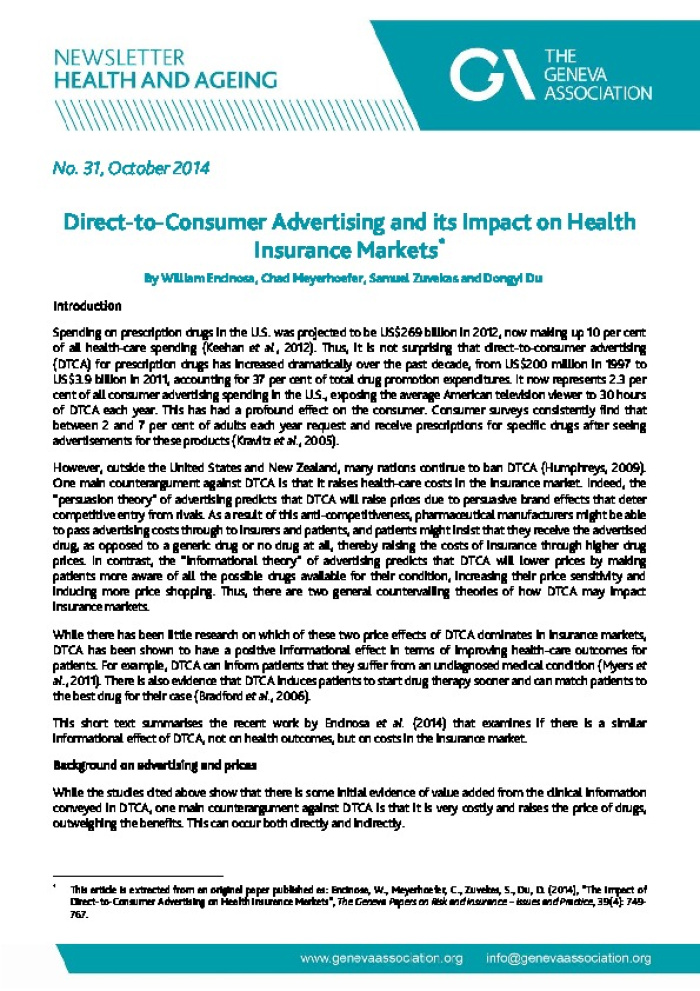Direct-to-Consumer Advertising and its Impact on Health Insurance Markets
Health & Ageing Newsletter 31: William Encinosa et al. examine whether Direct-to-Consumer advertising raises costs in health insurance markets or makes these markets more efficient in drug pricing.

No. 31, October 2014 Direct -to -Consumer Advertising and its Impact on Health Insurance Markets * By William Encinosa, Chad Meyerhoefer, Samuel Zuvekas and Dongyi Du Introduction Spending on prescription drugs in the U.S. was projected to be US$269 billion in 2012, now making up 10 per cent of all health-care spending (Keehan et al. , 2012). Thus, it is not surprising that direct -to -consumer advertising (DTCA) for prescription drugs has increased dramatically over the past decade, from US$200 m illion in 1997 to US$3.9 billion in 2011, accounting for 37 per cent of total drug promotion expenditures. It now represents 2.3 per cent of all consumer advertising spending in the U.S., exposing the average American television viewer to 30 hours of DTCA each year. This has had a profound effect on the consumer. Consumer surveys consistently find that between 2 and 7 per cent of adults each year request and receive prescriptions for specific drugs after seeing advertisements for these products (Kravitz et al., 2005). However, outside the United States and New Zealand, many nations continue to ban DTCA (Humphreys, 2009). One main counterargument against DTCA is that it raises health -care costs in the insurance market. Indeed, the ?persuasion theory? of adver tising predicts that DTCA will raise prices due to persuasive brand effects that deter competitive entry from rivals. As a result of this anti -competitiveness, pharmaceutical manufacturers might be able to pass advertising costs through to insurers and pat ients, and patients might insist that they receive the advertised drug, as opposed to a generic drug or no drug at all, thereby raising the costs of insurance through higher drug prices. In contrast, the ?informational theory? of advertising predicts that DTCA will lower prices by making patients more aware of all the possible drugs available for their condition, increasing their price sensitivity and inducing more price shopping. Thus, there are two general countervailing theories of how DTCA may impact in surance markets. While there has been little research on which of these two price effects of DTCA dominates in insurance markets, DTCA has been shown to have a positive informational effect in terms of improving health -care outcomes for patients. For example, DTCA can inform patients that they suffer from an undiagnosed medical condition (Myers et al ., 2011). There is also evidence that DTCA induces patients to start drug therapy sooner and can match patients to the best drug for their case (Bradford et al., 2006). This short text summarises the recent work by Encinosa et al. (2014) that examines if there is a similar informational effect of DTCA, not on health outcomes, but on costs in the insurance market. Background on advertising and prices While the studies cited above show that there is some initial evidence of value added from the clinical information conveyed in DTCA, one main counterargument against DTCA is that it is very costly and raises the price of drugs, outweighing the benefits. This can occ ur both directly and indirectly. * This article is extracted from an original paper published as: Encinosa, W., Meyerhoefer, C., Zuvekas, S., Du, D. (2014), ?The Impact of Direct- to-Consumer Advertising on Health Insurance Markets?, The Geneva Papers on Risk and Insurance ? Issues and Practice, 39(4): 749 - 767.